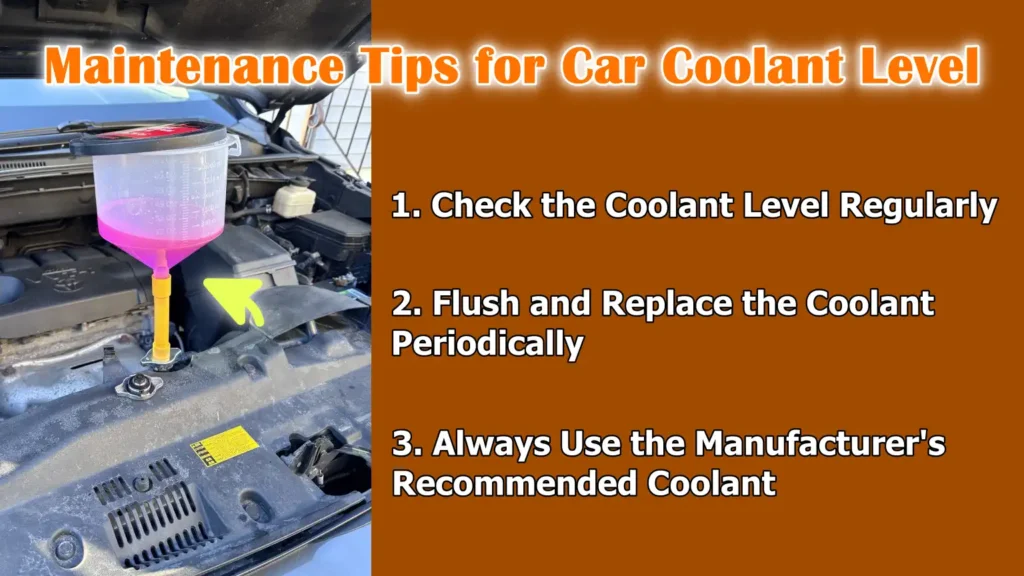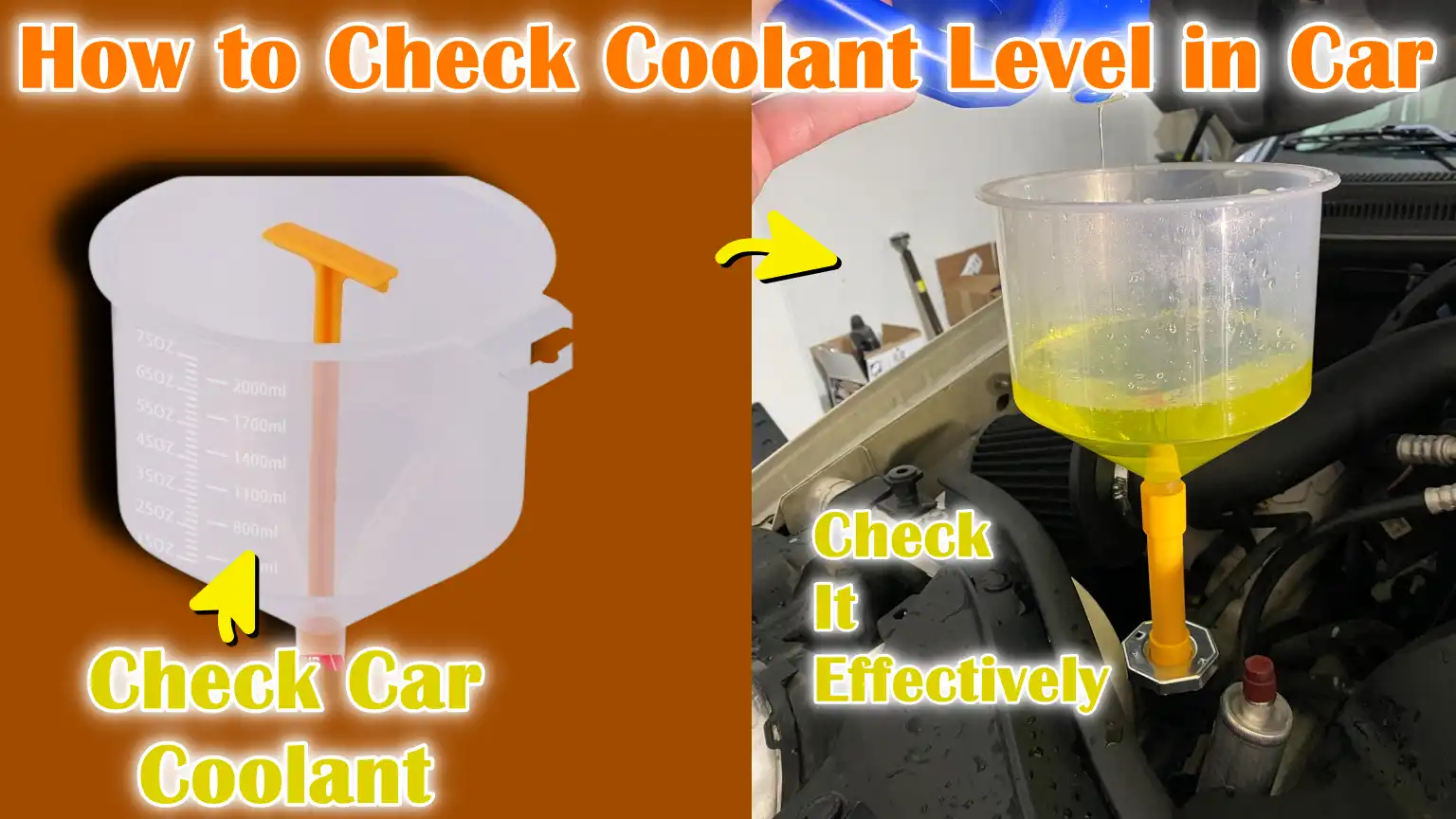Written By: Don Dodi
Fact Checked By: Kristen Brown
Reviewed By: Diego Rosenberg
Coolant is not just important as it keeps your engine cool, but it also protects it from any kind of rust, corrosion and freezing in winter as well.
Yes, coolant is also known as antifreeze, also remember that it is actually a vital liquid in every car that keeps the engine running at the right temperature.
And yes, it prevents the engine from overheating in the really hot weather and freezing when weather goes down, basically it ensures smooth performance and protects all kinds of critical parts such as: radiator, water pump and engine block as well.
Just understand this simple thing: that without the correct coolant lever, a car can overheat badly and then it can lead to the costly engine that damage or even leads to the complete engine failure as well.
Plus, it is really simple to check the coolant, yet many car owners actually overlook it like it is not important factor at all, but just keep this in mind that: if coolant is low or dirty then it also cause poor heating inside the car, corrosion can occur in the cooling system and also fuel efficiency can reduce as well.
So, this is the guide that shows you How to Check Coolant Level in Car, so that you can easily avoid unexpected breakdowns.
At First, Understand About the Car Coolant System
1. What the Coolant Reservoir and Radiator Do
The coolant system in a car is designed to regulate engine temperature and prevent it from overheating or freezing.
The coolant reservoir is a plastic container that holds excess coolant and allows the fluid to expand and contract as the engine heats up and cools down.
It is usually translucent, so the coolant level can be checked without opening it.
The radiator, on the other hand, is a large metal component located at the front of the engine bay.
It transfers heat from the hot coolant to the air passing through its fins, effectively cooling the fluid before it flows back into the engine.
The radiator and reservoir together maintain a stable engine temperature and ensure the engine operates efficiently and safely.
2. Different Types of Coolant
Not all coolants are the same and different types of coolants are designed to protect specific engines.
These typically come in different colors, such as green, orange, pink, or blue, which reflect their chemical composition.
Some coolants are inorganic additive technology (IAT), organic acid technology (OAT), or hybrid organic acid technology (HOAT) and each type reacts differently with the metals in the engine.
Using the wrong type of coolant can cause corrosion, reduce efficiency, or even damage the engine over time.
Coolant may also be sold as a concentrated liquid that needs to be mixed with water or as a pre-made solution.
3. Recommended Coolant Types Based on the Car Manufacturer’s Manual
Each car manufacturer specifies the type of coolant suitable for its engine in the owner’s manual.
This recommendation is based on the engine’s material, temperature tolerance and chemical compatibility.
Following the manufacturer’s instructions ensures maximum protection against overheating, freezing, corrosion and scale buildup.
To maintain the health and longevity of the engine, it is also important to check the coolant regularly and to top it up correctly, rather than just filling it with any coolant available.
Ensure Safety Precautions Before Checking
1. Make sure the engine is completely cool before opening the hood
Before checking the coolant level, it’s important to ensure the engine is completely cool.
The engine and its components can be very hot after driving and opening the hood while the engine is hot can cause burns.
Checking the coolant on a hot engine can cause an accidental leak, which can be dangerous.
Allowing the engine to cool for at least 30 minutes to an hour after driving ensures you can safely inspect the coolant without injury.
2. Never open the radiator cap when the engine is hot
The coolant inside the radiator is under pressure and opening the cap could release hot steam or boiling liquid, which could cause serious burns or injury.
Even if the coolant appears cool, pressure within the system can increase, making removing the cap extremely unsafe.
Always wait until the engine has completely cooled before opening the radiator or tank cap.
3. Park on a Level Surface and Apply the Parking Brake
For safety and accuracy, always park the car on a flat, level surface when checking the coolant.
Parking on a slope can cause the fluid in the tank to move unevenly, resulting in inaccurate readings.
Applying the parking brake keeps the car stable and stationary, preventing any accidental movements while checking or topping up the coolant.
This simple precaution makes the process safer and helps prevent leaks or accidents.
How to Locate Coolant Reservoir
1. Description of Where the Coolant Tank Is Typically Located
The coolant reservoir is typically a translucent plastic container located near the radiator at the front of the engine bay.
Its location is designed for easy access for checking and replenishing coolant.
Being translucent allows you to see the fluid level without opening the lid, which provides an additional layer of security.
This reservoir is connected to the radiator via a small hose and serves as a storage area for excess coolant, allowing the system to expand and contract as the engine heats up and cools down.
2. How to Identify It
The coolant reservoir is usually clearly labeled with the words “coolant” or “antifreeze” or marked with a thermometer symbol.
These labels help distinguish it from other fluid containers located in the engine bay, such as the windshield washer or brake fluid reservoir.
The color of the coolant inside the container may also provide a visual indication, typically green, orange, pink, or blue, depending on the type of coolant used.
3. Difference Between Radiator Cap and Reservoir Cap
It’s important to understand the difference between the coolant reservoir cap and the radiator cap.
The radiator cap is located directly on the radiator itself and should never be opened when the engine is hot due to the high pressure exerted on the engine.
On the other hand, it’s safer to open the reservoir cap after the engine has cooled down, as it’s designed to release pressure slowly.
Understanding the difference between these two caps ensures safe operation of the coolant system and prevents injuries from hot liquid or steam.
How to Check Coolant Level in Car
1. Visual Inspection of the Coolant Reservoir
The first step in checking the coolant level is to visually inspect the coolant reservoir.
Most reservoirs are made of translucent plastic, allowing you to see the fluid inside without opening the lid.
This makes monitoring the coolant safer and prevents unnecessary exposure to hot fluid or steam.
Just by looking at the container, you can quickly determine if the coolant needs attention.
2. Look for the “MIN” and “MAX” markings on the side of the tank
Marks on the side of the coolant reservoir indicate the minimum (MIN) and maximum (MAX) levels.
These markings serve as a guide to maintaining the coolant within the correct range.
The fluid should never fall below the MIN mark, as this can cause the engine to overheat and potentially cause damage.
Filling above the MAX mark is also not recommended, as this can increase system pressure and cause leaks.
3. Check if the coolant level is between these marks
After looking at the MIN and MAX markings, check if the coolant level is within this safe range.
If the fluid is below the MIN mark, it needs to be topped up.
If it is above the MAX mark, some coolant may need to be removed to prevent overflow.
Maintaining the correct level ensures that the engine operates efficiently and is protected from extreme temperatures.
4. Pay Attention to the Color and Clarity of the Coolant
When checking the level, it’s also important to pay attention to the color and clarity of the coolant.
Fresh coolant is typically bright green, orange, pink, or blue, depending on the type.
If the coolant appears rusty, brown, or cloudy, it could be a sign of corrosion, contamination, or that the coolant has deteriorated and needs to be replaced.
Clear and transparent coolant not only helps regulate engine temperature but also protects the cooling system from damage and blockages.
How to Add Coolant – If You See the Level is Low
1. How to Safely Remove the Reservoir Cap
Before adding coolant, it’s important to safely remove the reservoir cap.
Ensure the engine has completely cooled down to avoid burns or pressure-related accidents.
Turn the cap slowly and carefully to release any residual pressure.
Some caps may produce a slight hiss when opened, which is normal, but should be handled with caution.
Only after the cap is safely removed can you begin refilling the coolant.
2. Add the Correct Coolant Mix
Coolant should be added according to the manufacturer’s recommendation, usually a 50/50 mix of coolant and distilled water, unless it’s pre-mixed.
Using distilled water prevents mineral deposits from forming inside the cooling system, which can block hoses or damage the radiator.
Add the liquid slowly so that it settles and doesn’t create air bubbles in the reservoir, as trapped air can reduce cooling efficiency.
3. Avoid Overfilling
It’s important to fill the coolant only to the “max” line marked on the reservoir.
Overfilling can create excessive pressure in the cooling system and cause leaks or damage hoses and seals.
Maintaining the fluid level within the proper range keeps the cooling system functioning effectively and prevents engine overheating and other problems.
4. Securing the Cap After Filling
After filling with coolant, securely reinstall the reservoir cap to ensure a proper seal.
A strong seal prevents leaks and maintains proper pressure in the cooling system.
Double-check that the cap is fully in place before starting the engine, as a loose cap can cause coolant to leak or evaporate, reducing cooling system efficiency and posing a safety hazard.
What to Do After Checking or Refilling It
1. Start the engine and let it run for a few minutes
After checking or refilling the coolant, start the engine and let it run for a few minutes.
This allows the coolant to circulate throughout the engine and radiator, ensuring that all parts of the cooling system are properly filled and functioning.
Running the engine also expels trapped air bubbles in the system, improving heat transfer efficiency and preventing hot spots in the engine.
2. Monitor for any leaks or sudden drops in level
While the engine is running, carefully inspect the coolant reservoir and surrounding areas for signs of any leaks.
A sudden drop in coolant level could indicate a loose cap, a leak in a hose, or damage to another part of the cooling system.
Early detection of problems helps prevent engine overheating and costly repairs, as a leak or system failure can quickly escalate if not addressed immediately.
3. Recheck the coolant level after the engine has cooled down and then run it for a while
After driving the car for a while, let the engine cool completely and then recheck the coolant level.
This ensures that the coolant has settled completely in the system and that its level is within safe limits.
Regularly rechecking the coolant level after refilling maintains stable engine performance, prevents engine overheating and ensures that the cooling system continues to function efficiently over time.
When You Should Ask For Professional Help
1. Coolant Continuously Dropping Below “MIN”
If you notice that the coolant level repeatedly drops below the “MIN” mark, despite regular refills, it could indicate a leak somewhere in the cooling system.
The leak could be in a hose, radiator, water pump, or other components.
It’s important to identify and repair the leak immediately because low coolant levels can cause the engine to overheat and cause serious damage.
A professional mechanic can locate the source of the leak and make the necessary repairs to ensure proper system functioning.
2. Presence of Oil or Sludge in the Coolant
Oily, brown, or cloudy-looking coolant could indicate a serious internal problem, such as a blown head gasket or engine contamination.
Oil in the coolant can damage the cooling system, reduce heat transfer efficiency and cause corrosion inside the engine.
If you notice these symptoms, it’s important to take your car to a qualified mechanic immediately, as ignoring this problem can cause significant and costly engine damage.
3. Engine Overheating Despite Correct Coolant Levels
Despite correct coolant levels, the engine may overheat if there are problems with other components of the cooling system, such as a faulty thermostat, a clogged radiator, a malfunctioning water pump, or air trapped in the system.
Persistent overheating is a serious warning sign that requires professional attention.
Mechanics can perform a detailed diagnosis to identify the root cause and make necessary repairs to prevent further engine damage and ensure safe operation.
Read More:
Maintenance Tips for Car Coolant Level

1. Check the Coolant Level Regularly
To keep your car’s engine running smoothly and prevent overheating, it’s important to check the coolant level at least once a month.
This is specially important before long trips, as long drives can put extra strain on the engine and increase the risk of overheating.
Regular checks help detect early signs of leaks or low coolant, allowing you to address minor problems before they lead to costly repairs.
2. Flush and Replace the Coolant Periodically
Over time, coolant can lose its effectiveness and become contaminated with rust, dirt, or chemical deposits.
To maintain optimal engine performance and protect the cooling system, it’s recommended to flush and replace the coolant every 2 to 5 years, depending on the vehicle manufacturer’s guidelines.
This process removes old fluid and harmful debris, ensuring that new coolant can circulate efficiently and prevent corrosion or blockages.
3. Always Use the Manufacturer’s Recommended Coolant
Using the correct type of coolant, as specified in the car owner’s manual, is essential for engine safety and longevity.
Different engines require specific chemical formulations to prevent corrosion, freezing and overheating.
Using the wrong type of coolant can cause chemical reactions, reduce cooling capacity and even damage internal engine components.
Always follow the manufacturer’s advice to keep your car’s cooling system healthy.
Plus, there’s a study by MDPI which shows that there’s different kinds of effects of the different coolant formulations on radiator heat-transfer effectiveness and corrosion rates, that shows that there’s measurable differences in cooling performance and metallic corrosion which actually depends on coolant chemistry and shows that some formulations actually reduces radiator corrosion better than others as well, which is why coolant type such as: IAT, OAT & HOAT, actually matters for both cooling efficiency and corrosion protection.[¹]
Conclusion – How to Check Coolant Level in Car
Simply if you just look at your coolant reservoir that can literally save you from having a sudden breakdown on a hot summer day or a frozen engine in the winter weather conditions.
Coolant regulates engine temperature, prevents overheating and protects components from rust, corrosion and freezing.
Regularly checking coolant, paying attention to its color and clarity and refilling with the correct mixture can prevent costly engine repairs and extend your car’s life.
Following safety precautions, using the manufacturer’s recommended coolant type and monitoring for leaks or unusual changes in the fluid all contribute to a reliable and safe driving experience.
By making these checks part of your regular maintenance, you can avoid unexpected breakdowns, improve fuel efficiency and keep your vehicle performing at its best in all seasons.
So, that’s it from this guide and you can ask more questions in the comment box.
Frequently Asked Questions
Q1. Can the radiator cap be opened when the engine is hot?
Answer: No, you should never open the radiator cap when the engine is hot. The coolant inside the radiator is under pressure and opening the cap could release hot steam or boiling liquid, which could cause serious burns. Always wait until the engine has completely cooled before opening the radiator or reservoir cap.
Q2. What is the difference between a radiator cap and a coolant reservoir cap?
Answer: The radiator cap is located directly on the radiator and is designed to handle high pressure. It should only be opened when the engine is completely cool. The coolant reservoir cap is located on a transparent plastic container attached to the radiator and it is usually safe to open it after the engine has cooled. The reservoir allows the coolant to expand and contract as the engine heats up and cools down, making checking the level safe and easy.
Q3. What type of coolant should I use for my car?
Answer: You should always use the coolant recommended by your car manufacturer, which is listed in the owner’s manual. Coolants come in various colors and chemical compositions, such as green, orange, pink, or blue. Using the wrong type of coolant can cause corrosion, reduce cooling efficiency and potentially damage engine parts. Some coolants come pre-mixed with water, while others need to be diluted with distilled water. Always follow the instructions carefully.
Q4. How do I know if my coolant needs to be replaced?
Answer: Depending on the car manufacturer’s recommendations, coolant should be changed every 2 to 5 years. You can also tell if your coolant needs to be replaced if it appears rusty, cloudy, or turbid. Fresh coolant is usually bright and clear in color. Old or contaminated coolant loses its ability to regulate engine temperature and can damage the cooling system, so timely replacement is crucial.
Q5. What should I do if my car is constantly leaking coolant?
Answer: If the coolant level continues to drop below the minimum level even after refilling, there may be a leak in the cooling system. This could be in the hoses, radiator, water pump, or other engine components. Continuous coolant loss should be investigated by a professional mechanic to prevent engine overheating or damage.
References
[1] Ardika, R.D.; Sudarno, S.; Winangun, K.; Pangesthu, C.S.; Nuri, N.R.M.; Effendy, M. The Effect of Using Variations of Radiator Coolant on the Effectiveness of Engine Cooling and the Rate of Corrosion of Radiator Materials in 1300 cc Cars
https://www.mdpi.com/2673-4591/84/1/11

Guys, I’m a car audio enthusiast and customization expert and I love clear sound and clean installation. Plus, I have spent years helping people build their dream audio setups. And whenever I’m working on cars, I probably listen to music and thinks about the next big upgrade.

